拋磚引玉之寬度自適應布局
什麼是寬度自適應布局呢?
就是當浏覽器窗口大小改變時,浏覽器裡的元素寬度也隨之改變,從而達到自適應布局。
常見的寬度自適應布局有:
1、 兩列:左邊寬度不變,右邊寬度自適應
2、 三列:左右兩邊寬度不變,中間部分自適應
3、 三列:左右兩邊寬度自適應,中間部分不變
一、利用div+css實現以上“自適應布局”(1)兩列:左邊寬度固定,右邊寬度自適應
利用div+float+margin,已在隨筆‘float剖析’中講解,具體代碼和效果圖見下:

<!DOCTYPE html>
<head>
<title>width_layout</title>
<meta http-equiv="Content-Type" content="text/html; charset=gb2312"/>
<style type="text/css">
.content {
min-width:300px;
}
.div1 {
width:200px;
height:300px;
background:green;
float:left;
}
.div2 {
height:300px;
background:pink;
margin-left:200px;
}
</style>
</head>
<body>
<div class="content">
<div class="div1"></div>
<div class="div2"></div>
</div>
</body>
</html>
View Code
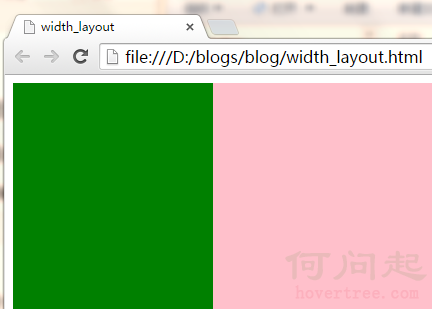
(2)三列:左右兩列寬度固定,中間部分自適應
思路:將左右兩列分別設置為左浮動和右浮動,中間的列寬度不管,將它的margin-left和margin-right設置為與左右兩列的固定寬度一致。
具體代碼和效果圖見下:

<!DOCTYPE html>
<head>
<title>layout2</title>
<meta http-equiv="Content-Type" content="text/html; charset=gb2312"/>
<style>
* {
margin:0;
padding:0;
}
.main {
height:300px;
width:100%;
min-width:400px;
}
.main_left {
height:300px;
width:200px;
float:left;
background-color:green;
text-align:center;
}
.main_center {
height:300px;
margin-left:200px;
margin-right:100px;
text-align:center;
background-color:pink;
}
.main_right {
height:300px;
width:100px;
float:right;
text-align:center;
background-color:blue;
}
</style>
</head>
<body>
<div class="main">
<div class="main_left">我是左邊部分,寬度不變</div>
<div class="main_right">我是右邊部分,寬度不變</div>
<div class="main_center">
我是中間部分,寬度自適應
</div>
</div>
</body>
</html>
View Code
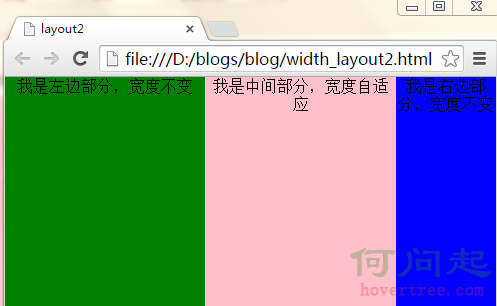
(3)三列:左右兩列寬度自適應,中間列寬度固定不變
思路:倘若左右兩列寬度一樣,左右兩列將其寬度各設置為父元素的50%,然後再將左右兩列的margin-left設置為中間列固定寬度的一半,然後將這三列都左浮動,就ok了。
具體代碼及效果見下:

<!DOCTYPE html>
<head>
<title>layout3</title>
<meta http-equiv="Content-Type" content="text/html; charset=gb2312"/>
<style>
body {
min-width:500px;
}
#left,
#right {
float: left;
margin: 0 0 0 -101px;
width: 50%;
height:58px;
*width: 49.9%;
}
#main {
width: 200px;
height:58px;
float: left;
background: green;
}
.inner {
height: 100%;
}
#left .inner,
#right .inner {
margin: 0 0 0 101px;
background: orange;
}
</style>
</head>
<body>
<div id="left">
<div class="inner">left</div>
</div>
<div id="main">
<div class="inner">中間width不變,兩邊自適應</div>
</div>
<div id="right">
<div class="inner">right</div>
</div>
</body>
</html>
View Code
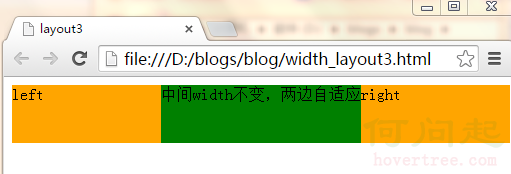
由於table自帶一些特性,所以實現以上三種布局,比較容易。
在這裡用到的table特性就是文字自動垂直居中,當不設置td的寬度width時,浏覽器自動渲染。
(1)兩列:左邊寬度固定,中間部分自適應

<!DOCTYPE html>
<head>
<meta http-equiv="Content-Type" content="text/html; charset=gb2312"/>
<title>table_layout</title>
<style>
.m_table {
width:100%;
height:100px;
text-align:center;
}
.left_td {
width:300px;
background-color:#98FF1A;
}
.right_td {
background-color:#7CC0FF;
}
</style>
</head>
<body>
<table class="m_table">
<tr>
<td class="left_td">這個是左邊部分,寬度確定</td>
<td class="right_td">這個是右邊部分,寬度自動擴展</td>
</tr>
</table>
</body>
</html>
View Code
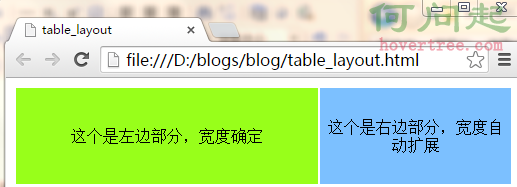
(2)三列:左右兩列寬度固定,中間部分自適應

<!DOCTYPE html>
<head>
<meta http-equiv="Content-Type" content="text/html; charset=gb2312"/>
<title>table_layout2</title>
<style>
.m_table {
width:100%;
height:400px;
text-align:center;
}
.left_td {
width:200px;
height:300px;
min-width:200px;
background-color:green;
}
.center_td {
height:300px;
background-color:pink;
}
.right_td {
width:200px;
height:300px;
min-width:200px;
background-color:blue;
}
</style>
</head>
<body>
<table class="m_table">
<tr>
<td class="left_td">我是左邊部分,寬度不變</td>
<td class="center_td">我是中間部分,寬度自適應</td>
<td class="right_td">我是右邊部分,寬度不變</td>
</tr>
</table>
</body>
</html>
View Code
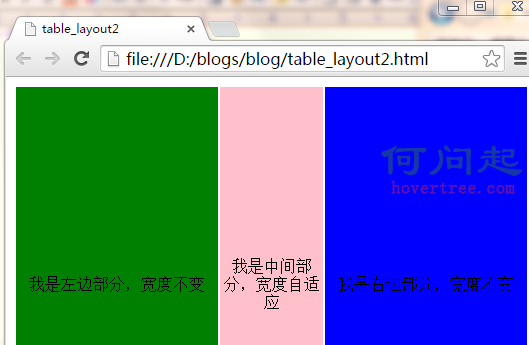
(3)左右兩列寬度自適應,中間列寬度固定不變

<!DOCTYPE html>
<head>
<meta http-equiv="Content-Type" content="text/html; charset=gb2312"/>
<title>table_layout3</title>
<style>
.m_table {
width:100%;
min-width:500px;
height:58px;
text-align:center;
}
.left_td {
height:58px;
background-color:orange;
}
.center_td {
height:58px;
width:200px;
background-color:green;
}
.right_td {
height:58px;
background-color:orange;
}
</style>
</head>
<body>
<table class="m_table">
<tr>
<td class="left_td">我是左邊部分,寬度自適應</td>
<td class="center_td">我是中間部分,寬度不變</td>
<td class="right_td">我是右邊部分,寬度自適應</td>
</tr>
</table>
</body>
</html>
View Code
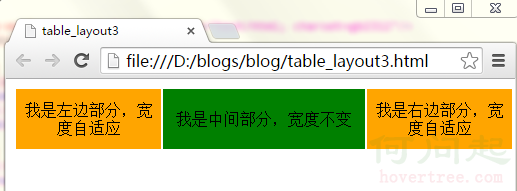
對於這兩個概念的區別以及優劣勢,網站建設的設計師和SEO者已經是再熟悉不過了,眾所周知DIV+CSS的優勢,也都清楚table布局已經趨於淘汰,現在極少數人會使用table去建網站了。對於二者的區別,網上早有大量的文章,在下就列舉幾點談談。
1、 table結構的網站是按照表格一格一格的打開的速度很慢;DIV+CSS結構的網站打開速度快。
2、 div+css的網站適合百度蜘蛛爬行。可以這麼說,百度蜘蛛喜歡div+css結構的站,不喜歡table結構的站,因為後者爬起來太費勁。
3、 table結構的站,架構過於單調,一眼看去就顯得方方框框的感覺,如果想實現圓潤或者流線的效果,必須繪制大量的邊框圖片。而div+css的站,樣式及其豐富,可以利用結構做出豐富的效果。
4、 table結構的站,頁面樣式都在頁面代碼裡面,不但代碼冗余,可讀性和再次開發性差,而且修改起來麻煩;Div+css的結構,結構與樣式分離,可讀性和二次修改都極其方便。
- 上一頁:BFC之寬度自適應布局篇
- 下一頁:css3中的動畫功能
